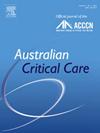儿童重症监护病房获得性虚弱的危险因素和6个月预后
IF 2.7
3区 医学
Q2 CRITICAL CARE MEDICINE
引用次数: 0
摘要
重症监护病房获得性虚弱会导致不良预后、医疗费用和资源。我们对儿科重症监护病房获得性虚弱(PICU-AW)知之甚少。目的本研究的目的是确定PICU-AW患者出院后6个月的危险因素和预后。方法:从2021年5月至2022年12月,在中国的一个中心进行了一项前瞻性观察研究。7 ~ 18岁患儿出院时分为有PICU-AW组和无PICU-AW组。使用预先设计的数据表收集患者的特征。危险因素分析采用单因素和多因素logistic分析。在出院后1、3和6个月评估肌肉力量、功能状态和健康相关生活质量(HRQOL)等结果。结果172例患者出院时符合条件,44例(25.6%)被诊断为PICU-AW。入院时存在全身性炎症反应综合征(优势比[OR]: 6.482, 95%可信区间[CI]: 2.245-18.712, p = 0.001),入院时儿科Logistic器官功能障碍2评分较高(OR: 1.337, 95% CI: 1.011-1.767, p = 0.041), PICU住院时间较长(OR: 1.222, 95% CI: 1.133-1.318, p <;0.001)与PICU-AW显著相关。PICU-AW是出院后1个月(OR: 5.215, 95% CI: 1.147-23.715, p = 0.033)和3个月(OR: 5.318, 95% CI: 1.759-16.077, p = 0.003) HRQOL下降的独立危险因素。PICU-AW与出院后6个月内的功能状态无关。结论入院时出现全身性炎症反应综合征、入院时脏器功能障碍、PICU住院时间较长是PICU- aw的独立危险因素。PICU-AW是患者出院后1、3个月HRQOL下降的独立危险因素。基线功能正常的患儿出院后更容易恢复功能状态。本文章由计算机程序翻译,如有差异,请以英文原文为准。
Risk factors and 6-month outcomes of paediatric intensive care unit–acquired weakness
Background
Intensive care unit–acquired weakness results in adverse prognosis, healthcare costs, and resources. Little is known about paediatric intensive care unit–acquired weakness (PICU-AW).
Objective
The goal of this study was to determine risk factors and 6-month outcomes after discharge of patients with PICU-AW.
Methods
From May 2021 to December 2022, a prospective observational study was conducted in a single centre from China. Children aged 7–18 years were divided into two groups with and without PICU-AW at discharge. A predesigned data form was used to collect patients' characteristics. Risk factors were analysed by univariate and multivariate logistic analyses. Outcomes such as muscle strength, functional status, and health-related quality of life (HRQOL) were assessed at 1, 3, and 6 months after discharge.
Results
A total of 172 patients were assessed for eligibility at discharge, and 44 children (25.6%) were diagnosed with PICU-AW. The presence of systemic inflammatory response syndrome on admission (odds ratio [OR]: 6.482, 95% confidence interval [CI]: 2.245–18.712, p = 0.001), higher Pediatric Logistic Organ Dysfunction 2 score on admission (OR: 1.337, 95% CI: 1.011–1.767, p = 0.041), and longer length of stay in the PICU (OR: 1.222, 95% CI: 1.133–1.318, p < 0.001) were significantly associated with PICU-AW. PICU-AW was an independent risk factor for decreased HRQOL at 1 month (OR: 5.215, 95% CI: 1.147–23.715, p = 0.033) and 3 months (OR: 5.318, 95% CI: 1.759–16.077, p = 0.003) after discharge. PICU-AW was not associated with functional status within 6 months after discharge.
Conclusions
The presence of systemic inflammatory response syndrome on admission, organ dysfunction on admission, and longer PICU stays were independent risk factors for PICU-AW. PICU-AW was found to be the independent risk factor for decreased HRQOL at 1 and 3 months after discharge. Children with normal baseline function were more likely to recover their functional status after discharge.
求助全文
通过发布文献求助,成功后即可免费获取论文全文。
去求助
来源期刊

Australian Critical Care
NURSING-NURSING
CiteScore
4.90
自引率
9.10%
发文量
148
审稿时长
>12 weeks
期刊介绍:
Australian Critical Care is the official journal of the Australian College of Critical Care Nurses (ACCCN). It is a bi-monthly peer-reviewed journal, providing clinically relevant research, reviews and articles of interest to the critical care community. Australian Critical Care publishes peer-reviewed scholarly papers that report research findings, research-based reviews, discussion papers and commentaries which are of interest to an international readership of critical care practitioners, educators, administrators and researchers. Interprofessional articles are welcomed.
 求助内容:
求助内容: 应助结果提醒方式:
应助结果提醒方式:


